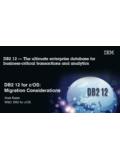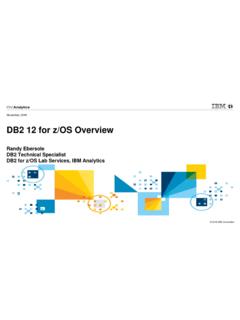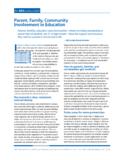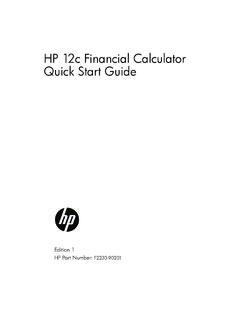Transcription of Performance and Availability DB2 11 for z/OS
1 Performance and Availability DB2 11 for z/OS YL&A 1999-2015 IBM is a registered trademark of International Business Machines is a trademark of IBM Corp. Copyright 1998-2015 YL&A, All rights YL&A 1999-2015 Disclaimer PLEASE READ THE FOLLOWING NOTICE The information contained in this presentation is based on techniques, algorithms, and documentation published by the several authors and companies, and in addition is the result of research. It is therefore subject to change at any time without notice or warning. The information contained in this presentation has not been submitted to any formal tests or review and is distributed on an As is basis without any warranty, either expressed or implied. The use of this information or the implementation of any of these techniques is a client responsibility and depends on the client s ability to evaluate and integrate them into the client s operational environment.
2 While each item may have been reviewed for accuracy in a specific situation, there is no guarantee that the same or similar results will be obtained elsewhere. Clients attempting to adapt these techniques to their own environments do so at their own risks. Slides, handouts, and additional materials distributed as part of this presentation or seminar should be reviewed in their entirety. YL&A 1999-2015 AbstractWith every new release of DB2 we look to see what features will allow us to improve the Performance of our existing applications and the Availability of our data. We also begin to plan to utilize new feature in our development efforts. This presentation takes a look at the features in DB2 11 that will both improve our Performance and provide us with maximum data Availability Brief discussion of overall Performance objectives of DB2 11 Discuss details on database Performance features and usage Discuss SQL.
3 Application and optimization Performance enhancements Discuss considerations for implementing new features and enhancements Review Availability enhancements and usage YL&A 1999-2015 Database and Subsystem Performance Enhancements Suppress null indexes Pseudo-deleted index entry cleanup Help for indirect references Large number of partitions access improvement No log declared temporary tables Incremental bind avoidance for DGTTs Parallelism support for DPSIs Partition elimination on join predicates Selective decompression RTS immediate externalization DSNACCOX improvements Access command parallelism Statistics feedback Work file usage improvements Reclassification of buffer pool pages 2G framesizesupport MRU queuing support for utilities New accounting for buffer pools New RBA/LRSN format Subsystem parameters for Performance YL&A 1999-2015 Database Availability and Data Sharing RELEASE(DEALLOCATE)
4 Thread interruption Cancel DDF threads Drop column Online alter limit key Deferred definition enhancement PIT Recovery for deferred schema changes Restart light with CASTOUT option Conditional propagation of child update locks Improved Performance in handling lock waiters Increase in maximum number of CF lock table entries Throttle batched unlock requests Improved IRLM resource hash table algorithm Group buffer pool write-around protocol Improved castout processing Improved DELETE_NAME Performance Automatic LPL recovery at end of restart Log record sequence number spin avoidance YL&A 1999-2015 Utilities Performance and Availability Improved Performance of partition-level REORG w/NPSI SWITCH phase impact reduction Physically delete empty partition-by-growth partitions Automated REORG mapping table management REORG change of defaults to match preferred practices REORG without SORTing data Partition-level inline image copy Improved REORG LISTDEF processing REBALANCE enhancements REORG of LOB enhancements Improved REORG serviceability RUNSTATS access path reset SYSLGRNX recording for catalog and directory RESTORE SYSTEM VCAT name translation Removal of incompatibility of REORG and COPY Removal of point-in-time recovery restrictions REPAIR Catalog LOAD SHRLEVEL NONE/CHANGE withPARALLEL Addition of crossloadersupport for XML More offload to zIIPwith NPSIs YL&A 1999-2015 SQL and Optimization Predicate selectivity overrides APREUSE WARN option Explain table enhancements Virtual index enhancements RID overflow processing Stage 2 predicate pushdown Correlated subquery conversion In memory sorts Duplicate removal during sort avoidance GROUP BY/DISTINCT early out for
5 Joins Early out processing Sparse index/hash joins Correlated subquery cache Invariant expression optimization Optimizer cost adjustments GROUPING SETS, ROLLUP and CUBE YL&A 1999-2015 Package based continuous block fetch Implicit commit for stored procedures DDF synchronous receive Multi-threaded Java stored procedures JDBC/ODBC stored procedure optimizations Cancel DDF thread improvementApplication, XML and Distributed Enhancements Global variables ARRAY data type Performance Autonomous SQL procedures Transparent archiving Cancel thread Cancel SQL Column processing Data type processing Rollback to savepoint Insert DOCID randomization Revalidation avoidance on LOAD XMLTABLE Remove unreferenced column definitions Merge common column path expressions Storage reuse for output XML columns Date/Time predicate pushdownOptimize index key rangePushdown of column casting Binary validation YL&A 1999-2015 Performance and Availability Opportunities When it comes to achieving the best Performance and Availability possible in DB2 we have to consider the following Expectations What new features look promising?
6 What problem are you looking to resolve with a new feature? Is it a better option than what you are doing today? Reality What effort is required to take advantage of new features? Will the usage achieve my goals? What features will be automatic and did their implementation hurt or harm my current Performance ? Usage To use some new features there may be large changes needed Rebinds, code changes, database changes Plan for efforts needed Evaluate effectiveness YL&A 1999-2015 Rebinds and Possible Changes Needed In memory usage/caching Select list non column expressions executed once RID overflow to work file usage for set functions DPSI page range screening join/correlation predicates and parallelism Statistics collection and feedback Filter factor hints Query rewrite for predicate indexability Stage 2 predicates pushdown(indexable) Merging of predicates with views/TEs Duplicate removal Reduction of indirect references No log DGTTsRebinds and Usage For Performance Improvements DB2 11 No RebindsNeeded Sort Performance Automatic index pseudo delete cleanup Data decompression Performance DPSI Performance for merge Improvements with large number of partitions XML Performance RELEASE(DEALLOCATE) optimization DGTT avoidance of incremental binds ROLLBACK TO SAVEPOINT Performance Suppress-null indexes xPROC sabove 2GB bar ACCESS DATABASE command Performance Data sharing/GBP improvements YL&A 1999-2015 DatabasePerformance YL&A 1999-2015 Suppress Null Indexes Issue DB2 must index every data row when creating an index Affects Performance and size of index It is useful to exclude one or more values from being indexed Values never used in a query( NULL, blank, 0)
7 DB2 11 (NFM) Improves insert Performance of NULL entries Option of excluding NULL rows from indexes Index entries not created when all values for indexed columns are NULL EXCLUDE NULL KEYS on CREATE INDEX Reduced index size Improves insert/update/delete Performance CREATE INDEX Performance should also improve RUNSTATS utility collect statistics only on non-NULL value Table statistics derived from index are adjusted by number of excluded NULL values Statistics will be same whether derived from a table scan, an EXCLUDE NULL KEYS index, or INCLUDE NULL KEYS indexCREATE NULL KEYS YL&A 1999-2015 Pseudo-Deleted Index Entries -Issue Issue: Index entries are not physically deleted when rows are deleted Unless delete operation has exclusive control of index page set Marked as pseudo-deleted Referred to as pseudo-deleted index entries Pseudo-empty index pages contain only pseudo-deleted index entries DB2 attempts to clean up pseudo-empty index pages during DELETE If some of pseudo-deleted entries in page are not committed during DELETE Cleanup cannot be performed Some pseudo-empty pages are likely not cleaned YL&A 1999-2015 Pseudo-Deleted Entries Issue ( )
8 Index entries are marked pseudo-deleted To handle a combination of other processes using index access And potential roll back of deleted rows Subsequent searches continue to access these pseudo-deleted entries Gradually degrade Performance as more rows are deleted Pseudo-deleted index entries can also result in time-outs and deadlocks For applications inserting data into tables with unique indexes Large amount of update activity can experience inconsistent Performance Need to REORG your tables and indexes Monitor PSEUDO_DELETE_ENTRIES in SYSINDEXPART If >10% of total index pages need index reorg Monitor NPAGES in INDEXSPACESTATS Number of pages with only pseudo-deleted entries Monitor REORGPSEUDODELETES in INDEXSPACESTATS Number of pseudo delete entries since last REORG Average transaction response time increases until a REORG INDEX is done Increased getpages, lock requests, CPUPSEUDO_DELETED_ENTRIES YL&A 1999-2015 In DB2 11(CM) In addition to any cleanup previously performed DB2 automatically deletes pseudo-empty index pages and pseudo deleted index entries Independent of SQL DELETE Cleanup is performed only on indexes that have been opened for INSERT/DELETE/UPDATE by other DB2 processes Pseudo deleted entries can be detected by SQL queries or INSERT/DELETE/UPDATE processes Can be a large number of pseudo deleted entries in an index If index is not already opened for INSERT/DELETE/UPDATE Cleanup does not happen DSNZPARM -control number of concurrent cleanup tasks On by default (1)
9 Can also be controlled via catalog tableAutomatic Pseudo Deleted Index Entry CleanupINDEX_CLEANUP_THREADS > 0 Runs under zIIP eligible SRBsSYSINDEXCLEANUP YL&A 1999-2015 Free Space Issue for Updates On partition or table space level Free space is defined CREATE/ALTER TABLESPACE Reserved during LOAD or REORG processing Used by insert but not update Insert can consume all free space if available Page is marked full when reaches designated percentage Nothing left for UPDATEs No easy way to managed free space for updates Causing indirect reference Driving more frequent REORGs YL&A 1999-2015 Indirect Reference Indicators RTS SYSTABLESPACESTATS and SYSINDEXSPACESTATS REORGNEARINDREF Number of overflow records created and relocated near pointer record REORGFARINDREF Number of overflow records created and relocated far from pointer recordSince last run of REORG or LOAD REPLACE, or object was created Catalog SYSTABLEPART NEARINDREF Number of rows relocated far from their original page FARINDREF Number of rows relocated far from their original pageIndirect Refs Row Count Near Increase Far Increase # Rows Increase 0 0 6,606,093 0 38,622 38,622 82,048 82,048 6,967,418 361,325 38,638 16 185,339 103,291 6,977,109 9,691 38,645 7 243,914 58,575 6,988,602 11,493 YL&A 1999-2015 Help for Reducing Indirect References Issue.
10 Updates to variable length and/or compressed rows can increase length If not enough space on data page Row is relocated to another data page Replaces original row with a pointer record Index entries continue to refer to original row (RID) Indirect references can cause additional I/O To read extra data page into buffer pool REORG TABLESPACE Removes indirect references DB2 11 PCTFREE FOR UPDATE attribute on table space/partition Reserves free space for updates DSNZPARM PCTFREE_UPD Default = 0 1 = DB2 uses RTS to determine setting SYSTABLEPART PCTFREE_UPD(defined) PCTFREE_UPD_CALC(Calc d by DB2 or utilities)PCTFREE_UPDPCTFREE FOR UPDATE YL&A 1999-2015 Large Number of Partitions -CPU Improvements Issue There is CPU overhead when using RELEASE(COMMIT) when a large (>200) number of partitions exist on the table DB2 11(CM) When using RELEASE(COMMIT) against a table with a large number of partitions (>200) May experience some Performance improvements Performance is not sensitive to the number of partitions defined Only sensitive to the number of partitions referenced under an individual COMMIT scope The larger number of partitions, the larger the Performance improvement observed Improvement is found for applications issuing a single SELECT statement that touches only one partition out of a large number of partitions (within a commit scope) Does not effect programs using RELEASE(DEALLOCATE) YL&A 1999-2015 DPSI Paral















